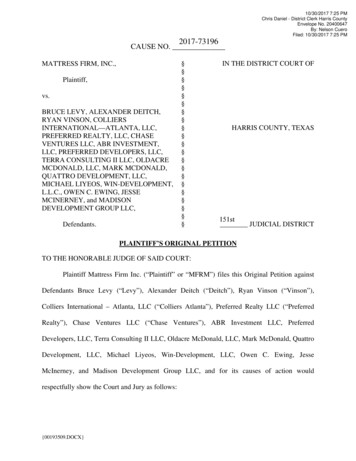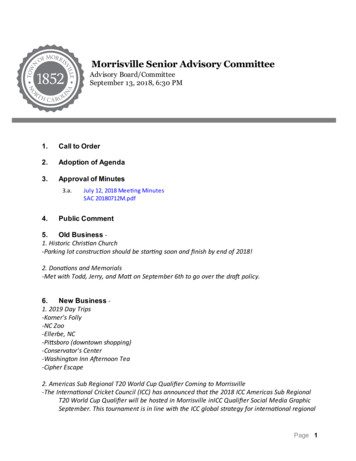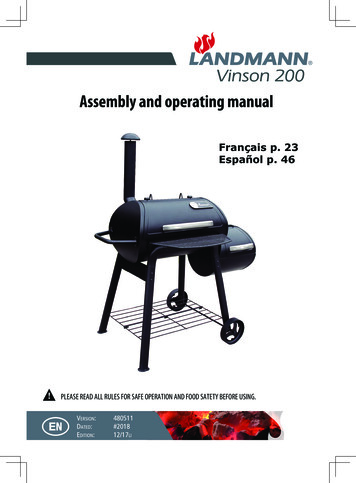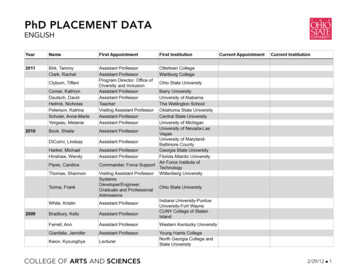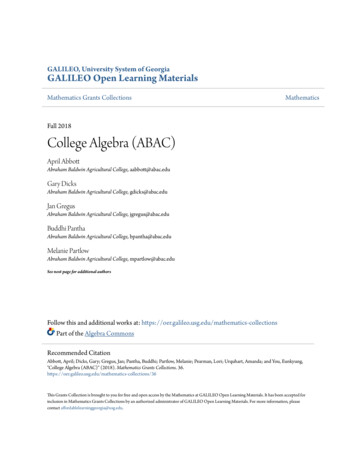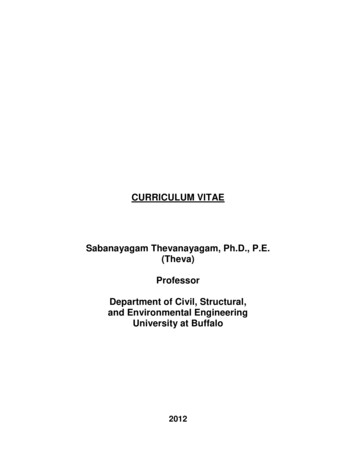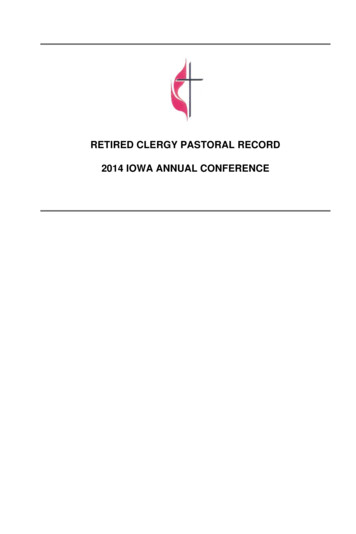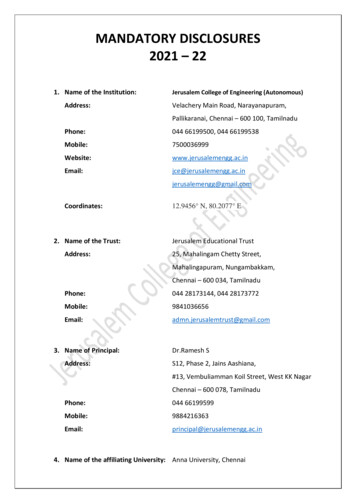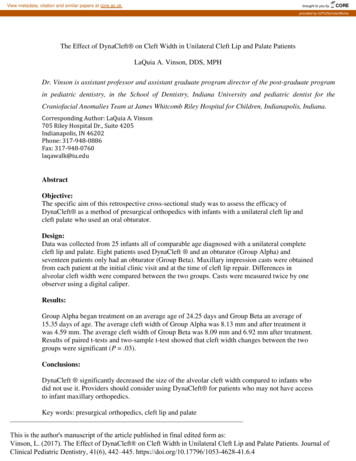
Transcription
View metadata, citation and similar papers at core.ac.ukbrought to you byCOREprovided by IUPUIScholarWorksThe Effect of DynaCleft on Cleft Width in Unilateral Cleft Lip and Palate PatientsLaQuia A. Vinson, DDS, MPHDr. Vinson is assistant professor and assistant graduate program director of the post-graduate programin pediatric dentistry, in the School of Dentistry, Indiana University and pediatric dentist for theCraniofacial Anomalies Team at James Whitcomb Riley Hospital for Children, Indianapolis, Indiana.Corresponding Author: LaQuia A. Vinson705 Riley Hospital Dr., Suite 4205Indianapolis, IN 46202Phone: 317-948-0886Fax: 317-948-0760laqawalk@iu.eduAbstractObjective:The specific aim of this retrospective cross-sectional study was to assess the efficacy ofDynaCleft as a method of presurgical orthopedics with infants with a unilateral cleft lip andcleft palate who used an oral obturator.Design:Data was collected from 25 infants all of comparable age diagnosed with a unilateral completecleft lip and palate. Eight patients used DynaCleft and an obturator (Group Alpha) andseventeen patients only had an obturator (Group Beta). Maxillary impression casts were obtainedfrom each patient at the initial clinic visit and at the time of cleft lip repair. Differences inalveolar cleft width were compared between the two groups. Casts were measured twice by oneobserver using a digital caliper.Results:Group Alpha began treatment on an average age of 24.25 days and Group Beta an average of15.35 days of age. The average cleft width of Group Alpha was 8.13 mm and after treatment itwas 4.59 mm. The average cleft width of Group Beta was 8.09 mm and 6.92 mm after treatment.Results of paired t-tests and two-sample t-test showed that cleft width changes between the twogroups were significant (P .03).Conclusions:DynaCleft significantly decreased the size of the alveolar cleft width compared to infants whodid not use it. Providers should consider using DynaCleft for patients who may not have accessto infant maxillary orthopedics.Key words: presurgical orthopedics, cleft lip and palateThis is the author's manuscript of the article published in final edited form as:Vinson, L. (2017). The Effect of DynaCleft on Cleft Width in Unilateral Cleft Lip and Palate Patients. Journal ofClinical Pediatric Dentistry, 41(6), 442–445. https://doi.org/10.17796/1053-4628-41.6.4
Introduction:Presurgical infant orthopedics can be defined as a type of therapy that “uses forces toreposition tissues secondarily displaced due to a cleft deformity”1. Orthopedic appliances weredeveloped to aid in the correction of cleft lip and palate by utilizing both compression andtension forces or passively guiding growth. Several authors have reported that presurgicalorthopedics have resulted in several additional benefits to patients with cleft lip and palate suchas: a reduction in cleft width by stimulation of patalal shelf growth, improved maxillary archdevelopment, improved growth of the face and infant overall, improved occlusion, feeding,speech, hearing, and language development2. Other reasons given for the use of presurgicalorthopedics include proper growth and development of the oral cavity, including proper posturefor the resting musculature including that of the tongue3. Ultimately, the molding that occurswith presurgical orthopedic use can result in a more uniform osseous base4.There are many methods of presurgical orthopedics for patients with cleft lip and palate.Nasoalveolar molding also known as NAM therapy orthotopically repositions both the alveolarsegments and nasal cartilages prior to cleft lip repair5. The effect of this type of presurgicalorthopedics is that a less extensive surgery is required for the lip and nasal repair and there is lesstension on the reconstruction, theoretically resulting more predictable reconstructive results.Indeed, greater nasal symmetry is be obtained after cleft lip repair using NAM therapy and NAMhas been demonstrated to be a cost effective means of cleft lip repair when patients are followedlong term6-7.Although NAM therapy is considered one of the most effective forms of presurgicalorthopedics, it is also one of the most time consuming procedures available to patients. NAM is alabor intensive technique that requires the construction of custom made alveolar splints and nasal
molding devices by the dental team. NAM therapy requires frequent visits, traditionally weekly,from the time of initial appliance placement until the time of lip repair surgery. This can increasethe number of office visits by 8 in unilateral cleft lip and palate patients. Lip adhesion surgeryhas been another method used in patients born with wide clefts, but it has been criticized for itsadditional risk and expense to patients as well as its high rate of dehiscence and scarring8.DynaCleft is a premade topical approximation device which has been successfully usedto mold the upper lip and alveolus, and support the developing nasal tissues prior to cleft liprepair (Figure 1). While traditional surgical adhesive tape (e.g. Silk tape, Steri-strips ) havebeen used in the past, unlike tape, DynaCleft offers the benefit of being able to provide aconstant approximation force with an elastic center that allows it to conform to a baby’s mouthbetter because of its ability to expand and contract9. Additionally, the controlled force that itprovides to the prolabium and premaxilla could improve cheiloplasty surgical results anddecrease the necessity of early lip adhesion surgery. As the DynaCleft device is premade, thereis no need to create custom-made devices for the molding process. Therefore, there is no laborcost associated with DynaCleft therapy unlike NAM therapy. Additionally, current researchhas demonstrated that adequate molding of the lip, alveolus, and nose can be accomplished usingDynaCleft through less frequent visits than required by NAM which decreases the burden onfamilies undergoing presurgical orthopedic treatment10.Nonetheless, one of the greatest benefitsof using DynaCleft in presurgical orthopedic therapy is the ability for families to minimizeclinical visits since no professional adjustment is needed to use it. It also has the ability to beused in conjunction with intraoral plates 9, 11. Parents are given both written and hands-oninstruction on how to place DynaCleft as well as how often to replace it. The specific aim of
this study was to assess the effect of DynaCleft as a method of presurgical orthopedics ininfants born with a unilateral cleft lip and cleft palate in reducing their alveolar cleft width.Methods:This retrospective study was conducted at an urban children’s hospital that serveschildren of a variety of ethnic backgrounds and was approved by the Institutional Review Boardas Study #1111007344. Data was collected from 25 infants diagnosed with a unilateral completecleft lip and palate over a three year period. All patients had maxillary alginate impressions forobturator fabrication obtained at their initial visit to the craniofacial center and immediatelybefore cleft lip repair surgery. The impressions were immediately poured in dental stone. GroupAlpha was provided DynaCleft (Southmedic, Ontario, Canada) at their initial clinic visit andthe parents received one-to-one and written instruction on its placement (Figure 1). Group Betawas composed of patients who had not received DynaCleft because they were patients of thecenter prior to its institution of the use of DynaCleft . The infants were all of comparable age,and were less than one month old at the time of their first visit.The dental casts that were created for the obturator fabrication were indirectly measured.Manual measurement of cast study models with a caliper is considered the gold standard12. Acoordinate system was utilized using conventional landmarks denoted on the casts: righttuberosity (RT) and left tuberosity (LT) points, right canine (RC) and left canine (LC) points, theincisal (I) point, right alveolar crest (RA) end point and left alveolar crest (LA) to standardize thepoints of measurement13. Each dental cast for the initial and follow up dates was measured twiceby one observer with a Carrera Precision digital caliper (Max Tool LLC, LaVerne CA), and theresults averaged and recorded into an electronic spreadsheet. The intersegment distance wasmeasured as the distance between the right and left tuberosity points, and the intercanine distance
was measured as the distance between the right and left canine points. The intercleft distance orcleft width was measured as the distance between the right and left alveolar crests. Differences inalveolar cleft width were compared within and between the two treatment groups. Alveolar cleftdistance was summarized and paired t-tests were used to test for significant changes between thepre-treatment and post-treatment measurements for each group. Two-sample t-tests were used tocompare the changes between groups.ResultsGroup Alpha began treatment on an average age of 24.25 days and Group Beta anaverage of 15.35 days of age. The average time between impressions for Group Alpha was 114days and for Group Beta 108 days. The average cleft width of Group Alpha (the DynaCleft group) was 8.13 mm and after treatment it was 4.59 mm. The average cleft width of Group Betawas 8.09 mm and 6.92 mm after treatment. Patients who had received DynaCleft saw anaverage decrease in cleft width of 3.5 mm while those who had not received DynaCleft saw anaverage decrease in cleft width of 1.17mm (Figure 3). The average intertuberosity andintercanine distances are listed in (Figure 4) which showed no significant changes in archdimensions. Results of paired t-tests and two-sample t-test showed that cleft width changesbetween the two groups were significant (P .03).DiscussionThis study was the first of its kind that assessed the effect of DynaCleft as a method ofpreoperatively reducing cleft width for infants with cleft lip and palate. While this study didshow that DynaCleft was effective in reducing cleft width in those patients who used it, theelastomeric properties of DynaCleft is the likely reason there was a decrease in cleft width.There were limitations of this study including the limited number of infants who were treated
with DynaCleft as well as the possibility of variability in following the treatment protocol forDynaCleft by caregivers of the patients.The primary goal of management of the cleft deformity is achieving normal anatomy andfunction with presurgical orthopedics serving as an adjunct for surgeons to accomplish this.14However, presurgical orthopedics still remains a controversial subject even though it has beenthe established practice of many craniofacial teams worldwide and has historically aided inreducing the size of the alveolar cleft prior to surgery.15 Yet, as it was noted by Adali andcolleagues, “the effect of presurgical orthopedics are manifested most clearly before the effectsof lip repair”, and, according to Prahl et al the effects don’t last beyond surgical soft palateclosure.2,16 Nonetheless, advantages such as facilitation of feeding, normalization of tonguefunction, reduced risk of aspiration, improvement of speech and archform provide justificationfor their continued use to many providers.14, 17In spite of the controversy that exists regarding the use of presurgical orthopedics in cleftlip and palate care, pediatric dentists will continue to play a vitally critical role in their use byfabricating them for nearly 35% of all craniofacial teams in the United States.18 Even thoughsurgical lip closure has a greater effect on decreasing cleft width than presurgical orthopedicsand the NAM procedure is still very widely used, those practitioners who still desire a method toreduce cleft width who do not have the resources to utilize NAM therapy do have a viable optionwith DynaCleft 19.ConclusionThe results of this study showed that using DynaCleft as a method of presurgicalorthopedics is an effective method of reducing cleft width. DynaCleft significantly decreasedthe size of the alveolar cleft width of patients with unilateral complete cleft lip and palate
compared to infants who did not undergo DynaCleft therapy. Nonetheless, this technique mayprovide teams who do not have access to more traditional methods of presurgical orthopedics aneffective alterative to use for treating these infants.AcknowledgementsI would like to thank Mr. George Eckert and Mr. Marvin Thomas for their assistance withthis study.Figure 1. Patient with DynaCleft in placeImage courtesy of Riley Hospital for Children Craniofacial Anomalies Center
Figure 2. Pre and Post DynaCleft castsImage courtesy of L.A. Vinson
Figure 3. Changes in alveolar cleft width
Figure 4. Changes in inter-tuberosity and inter-canine distanceGroup ywidth (mm)33.7434.480.74Inter-caninewidth (mm)29.0629.590.52Group .2233.361.140.900.62p GroupComparison
References1. Jaeger M, Braga-Silva J, Gehlen D, Sato Y, Zuker R, Fisher D. Correction of the Alveolar Gapand Nostril Deformity by Presurgical Passive Orthodontia in the Unilateral Cleft Lip. Ann PlasticSurg 59;489-494, 2007.2.Adali N, Mars M, Noar J, Sommerlad B. Presurgical orthopedics has no effect on archform inunilateral cleft lip and palate. Cleft Palate Craniofac J 49:5-13, 2012.3.Kozelj V. The basis for presurgical orthopedic treatment of infants with unilateral completecleft lip and palate. Cleft Palate Craniofac J 37:26-32, 2000.4.Marsh H, Vannier MW.Comprehensive Care for Craniofacial Anomalies.St. Louis, CV Mosby1985.5. Grayson, BH, Santiago PE, Brecht LE, Cutting CB. Presurgical nasoalveolar molding ininfants with cleft lip and palate. Cleft Palate Craniofac J 36:486-98, 1999.6. Barillas I, Dec W, Warren SM, Cutting CB, Grayson BH. Nasoalveolar molding improveslong-term nasal symmetry in complete unilateral cleft lip-cleft palate patients. Plast ReconstrSurg 123:1002-6, 2009.7.Pfeifer TM, Grayson BH, Cutting CB. Nasoalveolar molding and gingivoperiosteoplastyversus alveolar bone graft: an outcome analysis of costs in the treatment of unilateral cleftalveolus. Cleft Palate Craniofac J 39:26-9, 2002.8.Pool R, Farnworth TK.Preoperative lip taping in the cleft lip. Ann Plast Surg ?url -cleft-lip-approximation%2F&date 2015-11-0610.Monasterio L, Ford A, Guitierrez C, Tastets ME, Garcia J.Comparative study of nasoalveolarmolding methods: nasal elevator plus DynaCleft versus NAM-Grayson in patients withcomplete unilateral cleft lip and palate. Cleft Palate Craniofac J 50:548-54, 2013.11.Grayson BH, Cutting CB. Presurgical nasoalveolar orthopedic molding in primary correctionof the nose, lip, and alveolus of infants born with unilateral and bilateral clefts. Cleft PalateCraniofac J 38:193-8, 2001.12. Lewis BR, Stern MR, Willmot DR. Cleft Palate Craniofac J. Nov;45(6):639-46, 2008.13. Peltomäki T, Vendittelli BL, Grayson BH, Cutting CB, Brecht LE. Associations betweenseverity of clefting and maxillary growth in patients with unilateral cleft lip and palate treatedwith infant orthopedics. Cleft Palate Craniofac J 38:582-6, 2001.
14. Radhakrishnan V, Sabarinath VP, Thombare P, Hazarey PV, Bonde R, Sheorain A.Presurgical nasoalveolar molding assisted primary reconstruction in complete unilateral cleft lippalate infants J Clin Pediatr Dent. Spring;34(3):267-74, 2010.15. Kamble VD, Parkhedkar RD, Sarin SP, Patil PG Presurgical nasoalveolar molding (PNAM)for a unilateral cleft lip and palate: a clinical report J Prosthodont Jan;22(1):74-80, 2013.16. Prahl C, Kuijpers-Jagtman AM, van’t Hof MA, Prahl-Andersen B. A randomized prospectiveclinical trial into the effect of infant orthopaedics on maxillary arch dimensions in unilateral cleftlip and palate (Dutchcleft).Cleft Palate Craniofac J 40:337-342, 2003.17. Niranjane PP, Kamble RH, Diagavane SP, Shrivastav SS, Batra P, Vasudevan SD, Patil PCurrent status of presurgical infant orthopaedic treatment for cleft lip and palate patients: Acritical review. Indian J Plast Surg. Sep-Dec;47(3):293-302, 2014.18. Raju R, Tate AR, The Role of Pediatric Dentistry in Multidisciplinary Cleft Palate Teams atAdvanced Pediatric Dental Residency Programs Pediatr Dent 31:188-92, 2009.19. Prahl C, Kuijpers-Jagtman AM, van’t Hof MA, Prahl-Andersen B. A randomized prospectiveclinical trial into the effect of infant orthopaedics on maxillary arch dimensions in unilateral cleftlip and palate (Dutchcleft).Eur J Oral Sci 109:297-305, 2001.
DynaCleft is a premade topical approximation device which has been successfully used to mold the upper lip and alveolus, and support the developing nasal tissues prior to cleft lip repair (Figure 1). While traditional surgical adhesive tape (e.g. Silk tape, Steri-strips ) have

